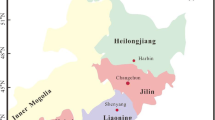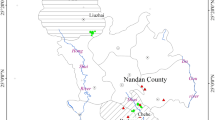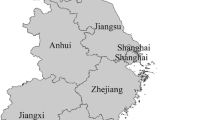Abstract
Cadmium (Cd) is considered as one of the most toxic and carcinogenic heavy metals. Accumulation of Cd in the human body can cause multiorgan dysfunction. Long-term irrational mining activities have led to serious Cd pollution in soil, water, and even agricultural products. Therefore, evaluating the Cd exposure levels of people living in mining areas is of great importance. In the current study, we chose the Pumi people who lived in Jinding and Tongdian towns of Lanping county in Yunnan province, China, to do the on-site nutritional epidemiology investigation and laboratory detection. We analyzed the content of the Cd in peripheral blood and mixed dietary, as well as water samples in the Pumi residents of the two towns. Results showed that the blood Cd levels of people in Jinding town, which is nearer the mining district, were statistically significantly higher than those in Tongdian town. The P 50 of blood Cd level of the two towns was 0.64 ng/mL. In addition, the P 50 of the mixed diet of the two towns was 8.32 μg/kg. There was a weak correlation between blood Cd levels and Cd exposure in the mixed diet, PTDI, and PTWI of the Pumi people. In addition, higher concentrations of Cd were observed in the water of Jinding town, indicating people in Jinding town risking more Cd exposure. These results indicated that diet and water are critical factors of Cd exposure for the residents and the nearer people living to mining district risking the more Cd exposure.


Similar content being viewed by others
References
Moon SS (2014) Additive effect of heavy metals on metabolic syndrome in the Korean population: the Korea National Health and Nutrition Examination Survey (KNHANES) 2009–2010. Endocrine 46:263–271
Lewis RC Meeker JD (2015) Biomarkers of exposure to molybdenum and other metals in relation to testosterone among men from the United States National Health and Nutrition Examination Survey 2011–2012. Fertil Steril 103: 172-178.
Protano C, Zinna L, Giampaoli S, Romano Spica V, Chiavarini S, Vitali M (2014) Heavy metal pollution and potential ecological risks in rivers: a case study from southern Italy. Bull Environ Contam Toxicol 92:75–80
Janik E, Grudzinski W, Gruszecki WI, Krupa Z (2008) The xanthophyll cycle pigments in Secale cereale leaves under combined Cd and high light stress conditions. J Photochem Photobiol B 90:47–52
Huang M, Choi SJ, Kim DW, Kim NY, Bae HS, Yu SD, Kim DS, Kim H, Choi BS, Yu IJ, Park JD (2013) Evaluation of factors associated with cadmium exposure and kidney function in the general population. Environ Toxicol 28:563–570
Sarvari E, Gaspar L, Solti A, Meszaros I, Zaray G, Fodor F (2010) Cd-Fe interactions: comparison of the effects of iron deficiency and cadmium on growth and photosynthetic performance in poplar. Acta Biol Hung 61(Suppl):136–148
Purello-D’Ambrosio F, Gangemi S, Minciullo P, Ricciardi L, Merendino RA (2000) Burning mouth syndrome due to cadmium in a denture wearer. J Investig Allergol Clin Immunol 10:105–106
Lai Y, Huang M, Li H, Wang XD, Li JL (2012) Distinct genotype distribution and haplotype profiles in MDR1 gene among Chinese Han, Bai, Wa and Tibetan ethnic groups. Pharmazie 67:938–941
Erzen IKragelj LZ (2006) Cadmium concentrations in blood in a group of male recruits in Slovenia related to smoking habits. Bull Environ Contam Toxicol 76:278–284
Hwang YH, Lin YS, Lin CY, Wang IJ (2014) Incense burning at home and the blood lead level of preschoolers in Taiwan. Environ Sci Pollut Res Int 21:13480–13487
Yin JZ, Feng YM, Wu SX, Zhang XH, Wang SM, Wang Q, Li Y, Qi DL (2014) Assessment of the iodine status of the Wa national boarding school students in southwest China. Biol Trace Elem Res 160:316–320
Tekin D, Kayaalti Z, Aliyev V, Soylemezoglu T (2012) The effects of metallothionein 2A polymorphism on placental cadmium accumulation: is metallothionein a modifiying factor in transfer of micronutrients to the fetus? J Appl Toxicol 32:270–275
Ikeda M, Moriguchi J, Sakuragi S, Ohashi F (2013) Relation of child birth and breast-feeding burden with cadmium and tubular dysfunction marker levels in urine of adult women in non-polluted areas in Japan. Int Arch Occup Environ Health 86:689–698
Becker K, Kaus S, Krause C, Lepom P, Schulz C, Seiwert M, Seifert B (2002) German Environmental Survey 1998 (GerES III): environmental pollutants in blood of the German population. Int J Hyg Environ Health 205:297–308
Ikeda M, Zhang ZW, Shimbo S, Watanabe T, Nakatsuka H, Moon CS, Matsuda-Inoguchi N, Higashikawa K (2000) Urban population exposure to lead and cadmium in east and south-east Asia. Sci Total Environ 249:373–384
Yang J, Kim EC, Shin DC, Jo SJ, Lim YW (2014) Human exposure and risk assessment of cadmium for residents of abandoned metal mine areas in Korea. Environ Geochem Health
Lopez-Herranz A, Cutanda F, Esteban M, Pollan M, Calvo E, Perez-Gomez B, Victoria Cortes M, Castano A, Bioambient Es, Bioambient ES (2015) Cadmium levels in a representative sample of the Spanish adult population: The BIOAMBIENT.ES project. J Expo Sci Environ Epidemiol
Park DU, Kim DS, Yu SD, Lee KM, Ryu SH, Kim SG, Yang WH, Park DY, Hong YS, Park JD, Lee BK, Moon JD, Sakong J, Ahn SC, Ryu JM, Jung SW (2014) Blood levels of cadmium and lead in residents near abandoned metal mine areas in Korea. Environ Monit Assess 186:5209–5220
Madeddu R, Solinas G, Forte G, Bocca B, Asara Y, Tolu P, Delogu LG, Muresu E, Montella A, Castiglia P (2011) Diet and nutrients are contributing factors that influence blood cadmium levels. Nutr Res 31:691–697
Moon CS, Paik JM, Choi CS, Kim DH, Ikeda M (2003) Lead and cadmium levels in daily foods, blood and urine in children and their mothers in Korea. Int Arch Occup Environ Health 76:282–288
Tsukahara T, Ezaki T, Moriguchi J, Furuki K, Shimbo S, Matsuda-Inoguchi N, Ikeda M (2003) Rice as the most influential source of cadmium intake among general Japanese population. Sci Total Environ 305:41–51
Marzec Z, Koch W, Marzec A, Zukiewicz-Sobczak W (2014) Dietary exposure to cadmium, lead and nickel among students from south-east Poland. Ann Agric Environ Med 21:825–828
Song XY, Wang F, Yuan BJ, Ma YJ, Wang X, Wang CN (2010) Resident dietary exposure of Cadmium in Jiangsu Province. Zhonghua Yu Fang Yi Xue Za Zhi 44:340–343
Panhwar AH, Kazi TG, Afridi HI, Arain SA, Arain MS, Brahaman KD, Naeemullah, Arain SS (2015) Correlation of cadmium and aluminum in blood samples of kidney disorder patients with drinking water and tobacco smoking: related health risk. Environ Geochem Health
Acknowledgments
The research was supported by The National Natural Science Fund, China (no. 81060237 and no. 81360427).
Conflict of Interest
The authors declare that they have no competing interests.
Author information
Authors and Affiliations
Corresponding authors
Additional information
Qi Wang and Yue-Mei Feng contributed equally to this work.
Rights and permissions
About this article
Cite this article
Wang, Q., Feng, YM., Wang, SM. et al. Assessment of the Cadmium Exposure in the Blood, Diet, and Water of the Pumi People in Yunnan, China. Biol Trace Elem Res 168, 349–355 (2015). https://doi.org/10.1007/s12011-015-0452-y
Received:
Accepted:
Published:
Issue Date:
DOI: https://doi.org/10.1007/s12011-015-0452-y




